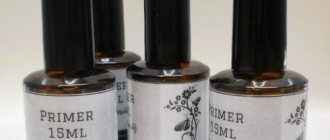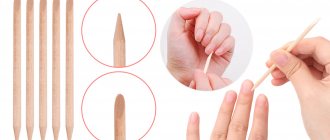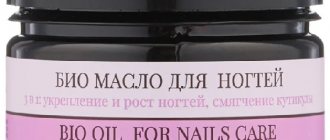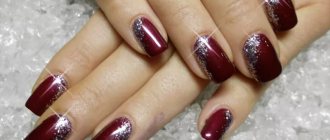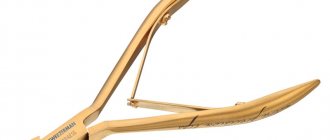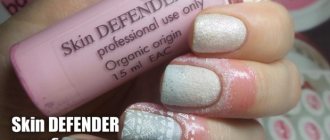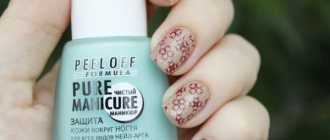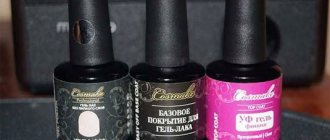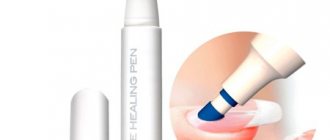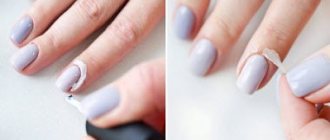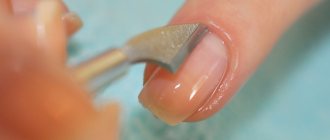Beautiful, well-groomed hands do not always imply the presence of a decorative coating on them. Much more important is the neat shape of your nails and smooth skin. Manicurists offer two ways to keep your nails and the area around them looking well-groomed:
- classic, or edged, manicure, in which dead skin is removed mechanically, that is, it is cut off with a special tool and then polished;
- European, or unedged, manicure, in which dead skin particles are dissolved with special means and removed using an orange stick or pusher.
But often the cuticle grows too much, and it is quite difficult to remove it mechanically at home, and it is also quite dangerous due to insufficient processing of the materials. Fortunately, there are many products that allow you to remove dead skin cells chemically.
Cuticle remover is a product that dissolves dead skin, thanks to which you can both maintain the effect of already cut cuticles and remove it without the use of scissors, nippers and tweezers. Essentially, it is a skin corrosive substance in low concentrations, affecting only “non-living” skin.
Initially, gel polish was removed with such means, dissolving it, and it was noticed how they act on the cuticle, softening it. Of course, softer, gentler products have been created for the skin.
Hitting the cuticle with a remover is suitable for girls with thin, sensitive skin, whose blood vessels are located too close and any touch with a cutting object causes bleeding. If the cuticle and pterygium are too active and constantly overgrow, then more severe intervention is required, but to maintain the beauty of the skin, it is recommended to use a remover.
How does the remover act on the cuticle?
Once on the skin, the product dissolves dry skin to such a stage that it can be removed without rubbing with an orange stick. Thanks to the chemical composition, healthy skin is not damaged. However, you should be careful when using such products, because there may be burns, damage to healthy cuticles, and allergies. To avoid this, use only high-quality products and strictly follow the instructions for use.
Remover advantages:
- suitable for sensitive hand skin and easily damaged cuticles;
- safety in use: the skin is not mechanically damaged;
- ease of use: not everyone can use cuticle nippers, especially not with their dominant hand;
- high speed of processing of the periungual space;
- the cuticle that was removed using a remover grows back more slowly and accurately, and hangnails appear less frequently;
- easy to apply and easy to remove from the nail plate;
- it can be used at home without fear of infection.
However, any remedy also has disadvantages. In fact, they are quite significant, so they are worth listing:
- The remover may not be suitable for people with allergies to various types of chemicals;
- the product cannot be applied only to the treatment area; in any case, it will flow onto the nail, which is completely unprofitable for it: the softened nail plate is easy to damage, as a result of which defects form on the nail: pits, tubercles, waves;
- For rough or neglected skin, unedged manicure is not suitable; in any case, you will have to mechanically remove the cuticle, since the remover, for our own safety, does not dissolve too deep layers of skin;
- impossibility of regular use, it is recommended to use the remover once a week to avoid allergic reactions;
- It is better not to use the product for skin damage and diseases, so as not to worsen the situation.
Remover functions
Women who are accustomed to doing their own manicure will be especially interested in the information below. Nail ridges and cuticles can be removed in two ways - mechanical (trimmed manicure) and chemical, which involves the use of a remover.
A highly qualified craftsman can carefully remove dead skin using tools without risk to health. Therefore, it is easier to do an unedged (English) manicure at home.
The procedure involves the use of a remover and an orange stick, which is commonly called a pusher. Although, this device can be made of any material.
Remover is a drug containing substances that act on dead skin. However, they are not able to have a negative effect on living epithelium. This method of performing a manicure is an excellent solution for women whose skin on their hands is delicate, sensitive and thin. Vessels located too close to the surface can also be a serious problem for the master. This circumstance makes it impossible to use tools.
How it works
When applied, the stratum corneum dissolves. Thanks to this effect, the cuticle is easily removed with a pusher. If the product is chosen incorrectly and used incorrectly, it can cause a chemical burn. The advantages of removers include:
- Can be used on sensitive hand skin.
- No chance of infection.
- Simplicity and convenience.
- Accelerated treatment of the periungual space and cuticle.
- No burrs.
- Slow regrowth, which is especially noticeable with regular use of the remover.
What type of tattoo can be removed using a remover?
The remover is suitable for removing permanent makeup applied to eyebrows or lips.
This procedure is recommended in the following cases:
- Asymmetry . An inexperienced artist can make the edges of the lips or eyebrows uneven. Minor flaws can be corrected during correction, but if the asymmetry is clearly expressed, then the tattoo will have to be removed.
- Inappropriate form . The reason for this defect may be either the lack of professionalism of the master or the desire of the client, who requires a certain shape to be made, although it does not suit her face type.
- Wrong shade chosen . So, a delicate blonde with jet-black eyebrows looks ridiculous.
- Uneven distribution of shade . Such a defect can appear not only due to the fault of the master, but also due to poor-quality dye.
Types of removers
Sometimes removers are mistakenly called keratolytics. This is incorrect, since a remover is a remedy, and a keratolytic is a substance included in its composition. The task of a keratolytic is to quickly and safely exfoliate dead cells from the skin. By their nature, keratolytics are:
- Alkaline. They have a gentle effect on fabric. As a rule, a remover with an alkaline keratolytic is not classified as an immediate remover. NaOH or KOH acts as a keratolytic.
- Acidic. Professionals prefer to use such removers. Cuticle dissolution time is 2 minutes. The use of such products requires compliance with safety precautions. Any mistake is fraught with the appearance of itching, allergies, redness and gradual thinning of the nail plate. The function of a keratolytic is performed by a water-soluble acid or a complex thereof. These are glycolic, lactic, citric acid, etc.
- Urea. The active ingredient is urea. Urea keratolytics are considered the most modern and safe. They are recommended for use by people who have any health problems (vascular diseases, diabetes, etc.). 10% drugs are classified as universal, 10-20% are designed for professionals. Products containing 20-30% urea are intended for pedicures in “severe cases”.
- Mineral. They are rare. They're not cheap. But they have a double effect: they remove the cuticle and nourish the nails with minerals. The composition contains auxiliary components: sea water, magnesium, calcium, silicon, zinc.
- Oily. Suitable for beginners. Oil by itself does not dissolve anything. It just makes the cuticle skin softer, which makes it easy to push it away with a pusher.
Difference Between AHA and BHA
The chemical term α-Hydroxy acids is unclear to many. These are alpha-hydroxy acids, which are part of removers designed to remove cuticles. They are moderately aggressive (lemon, milk, glycolic). Their task is reduced to deep penetration into the skin in order to destroy the bonds between “living” and “dead” cells.
For a pronounced effect, which is required in “advanced cases” or when performing a pedicure, it is more appropriate to use removers containing β-Hydroxy acids. These are beta-hydroxy acids (azelaic, phytic, salicylic, etc.), which have an intense effect on dead skin cells.
Classification by texture
Creamy, liquid and gel-like removers are available on sale. Each type has advantages and disadvantages. For example, liquid may flow under the nail bed, causing it to soften.
Creamy removers are more convenient as they do not spread, but they need to be rubbed in thoroughly. Of these, the gel is more preferable, but it matters which substance performs the keratolytic function.
Safe nail care - cuticle remover
Beautiful nails depend not only on good coverage and bright design. The most important thing is healthy natural nail plates, which are properly cared for. One of the good care products is a cuticle remover. This is a small area of skin that creeps onto the nail along the growth line.
First you need to figure out why the cuticle is needed and why it needs to be removed. The main function of this piece of skin is to protect against bacteria. But it constantly grows, growing into the nail plate, dries out and cracks, which leads to hangnails. Cuticle remover is best for eliminating these troubles. In addition, the overgrown part does not look aesthetically pleasing and interferes with the application of nail coatings, because it is much more pleasant to look at smooth, well-groomed nails without cuticles.
There are three ways to get rid of it:
When cutting the cuticle, you need to be very careful, removing only the keratinized, insensitive part, otherwise you can get an infection.
- The skin will become inflamed, it will hurt, this can affect the healthy growth of nails, in this case no coatings can be applied, and such a nail will not look aesthetically pleasing
- You can simply push it away with an orange stick, but since the skin firmly adheres to the plate, it is difficult to completely remove the keratinized particles. The varnish will not apply smoothly on such residues and will come off quickly.
- Using a cuticle remover is a very safe and high-quality method of eliminating this unpleasant skin.
Remover properties
Initially, remover was a product for removing makeup from sensitive skin or for removing stubborn cosmetics. Today there are removers for nails, eyelashes, hair and skin. A cuticle remover is a special product that directly acts on dead skin particles, softening them and dissolving them.
The main advantage of the remover is safety and painlessness, since after softening the skin is easily removed using a pusher. The disadvantage is the aggressive effect on the nails and surrounding skin.
It is important to apply remover only to the cuticle, as it dries the skin and softens the area of the nail that it touches.
Many people believe that softener can cause allergies.
There are several types of remover:
- The acidic one is the most aggressive, it is able to remove keratinized particles in just a minute. It is better not to use this product at home, since only professionals in salons can use it correctly
- Alkaline is more gentle, but its effect is delayed for about 20 minutes, but the harm to the nails is minimal
- Oil ones are very rare, but very safe. It can be used for very sensitive skin. It does not corrode the cuticle, but simply softens it
- Mineral products are the most useful, as they not only have a gentle effect, but are also enriched with beneficial microelements
The cuticle grows not only on the hands, but also on the feet; they also need care, so they also need a softening agent. Since the skin on the legs is rougher, to remove it you will need a substance containing AHA acid. It effectively fights rough skin, carefully removing dead particles.
Remover residues cannot be washed off with plain water; you must use soap to remove alkali.
You can also use micellar water to remove excess.
Selection rules
When choosing a remover, you should take into account the likelihood of allergic reactions to the “chemicals”. Financial capabilities and skin sensitivity threshold are taken into account. If a person plans to use a remover for the first time, then preference should be given to a drug with a mild effect. It is possible that it will be an oil remover.
If you intend to perform a pedicure, then “oil” will not work, since the skin on the feet is rougher than on the hands. It is recommended to use an alkaline remover. The option of using an acid remover should only be considered if you have experience. When choosing a chemical cuticle remover, you should always pay attention to the expiration date and information indicated on the packaging.
The gel-like preparation, enclosed in a jar with a special shape, is easy to use. The presence of an elongated dispenser spout is an obvious advantage. The option with a brush is also not bad, and it is considered economical, since applying the product with a brush minimizes the likelihood of overuse.
Who can and cannot use the product
The reason to resort to removal with a remover is a bad experience with eyebrow microblading,
permanent in any technique, the boring result of the old “eternal” tattoo.
Some clients suffer from pigment distortion towards red, gray, and blue. This happens if the dye is pushed too deep, or at the time of hormonal imbalance.
Inappropriate shape, asymmetry, unnatural lines and bends are among the indications for the service. You may also need to remove eyebrow tattooing with a remover before visiting a trusted PM specialist for a procedure in a modern, successful design. Overlapping the old pigment is impossible if you want to achieve a light natural shape and palette.
When looking at eyebrows after removal with a remover in a photo, it can be impossible to guess where the outlines of the old permanent were.
The procedure is contraindicated only if there is:
- bleeding disorders;
- inflammatory process in the acute phase;
- insulin-dependent form of diabetes;
- keloid scars;
- nervous tics, epilepsy and mental diseases that do not exclude involuntary movements in the body.
Using removers
Combi-technique (classic edged manicure + remover)
- Remove the coating from your nails and give them the desired shape.
- Using a pusher, push the skin around the perimeter of the nail.
- Apply remover.
- Leave the product for the required amount of time.
- If a wet technique is used, the remover is washed off with plain water. If it is dry, then wipe the treated area with a cotton pad moistened with micellar water.
- Lift and remove any remaining softened skin using a pusher.
- Trim the raised cuticle with scissors or tweezers.
- Treat the nail plates with a dehydrator and primer, and the skin around them with oil or care product.
Unedged (European) manicure
It has another name - acidic. The technique may involve both “soaking” your hands and performing a European manicure “dry”. If preference is given to the option without soaking, then the algorithm of actions is as follows:
- Remove the coating from your nails using any method.
- To move the thin skin, you can use a pusher made of metal, plastic or wood.
- Treat problem areas with remover. Wait for him to react.
- Remove cuticle.
- Treat the nail plates with oil or a special cosmetic.
If after this procedure it is planned to perform nail extensions or coating, then the remnants of the product containing keratolytics are eliminated with water. Next, the nails are treated with a degreaser and primer. “Wet” European manicure involves soaking your hands in water with a remover already applied. This is necessary for more intense softening.
Removing gel polish with remover
To remove shellac with a product that is not entirely intended for this purpose, you need to perform the following steps:
- Generously lubricate the skin around the nail plates with rich cream.
- Moisten a cotton pad with remover and apply to the nail plate. This procedure must be performed on each nail.
- Wrap each finger in foil (to prevent product evaporation).
- Remove cotton pads after 15 minutes.
- Remove any remaining coating using a pusher.
Which is better, remover or laser?
You can remove tattoos not only with a remover, but also with a laser. What is better remover or laser? Both procedures have their advantages and disadvantages.
After using the laser, the skin is practically not injured, so the recovery period is short. The remover is injected under the skin, so a crust forms at the injection site. In terms of the level of discomfort, both procedures are approximately the same; at the client’s request, topical anesthesia can be used.
Alternative to remover
If it is not possible to purchase a professional cuticle remover, then ordinary soda and salt baths can be an alternative. To prepare a soda solution you will need:
- liter of hot water;
- baking soda – 2 tsp.
For optimal effect, you can add a few drops of liquid soap to the solution. Keep your hands in the solution for 10 minutes. Of course, it will not dissolve the cuticle, but it will make it more pliable. The steamed peel can be easily moved with an orange stick and cut off with tweezers. Soda can be replaced with sea salt, and it is recommended to use lemon juice and any essential oil as auxiliary components. These ingredients are added to the solution in an amount of 5-7 drops.
How to use
In order for the manicure effect to last for a long time and to look neat, you should first pay attention to the step-by-step instructions. Remover is a safe product, but it has strong components that can adversely affect the health of sensitive skin.
You need to start the procedure by preparing your fingers. To do this, the previous decorative coating is removed from them and the free edge is given the desired shape. You should use a file for this.
After this, the fingertips are treated with an antiseptic, and work with the cuticle begins:
- The remover is distributed along the side rollers and in the area of dry epidermis at the base.
- After 2-3 minutes, use an orange stick or a metal pusher to push away the softened skin, lifting it slightly.
- Cut off the separated particles with nail scissors.
- Residues are removed with a cotton pad.
- If epidermal particles remain on the nail, repeat the procedure.
The girl is not prescribed any special care recommendations or restrictions after finishing work, since the integrity of the periungual area is not compromised during the session.
Allergy to removers
An allergic reaction is provoked by substances included in the composition of the products. The most problematic in this regard are removers with alkaline keratolytics. If alkali is introduced into the composition in high concentration, then people with hypersensitivity may experience allergies.
It is accompanied by the appearance of watery blisters, redness of the skin, and tingling. These are signs of a chemical microburn. When choosing a drug, your skin type must be taken into account. And if it is dry, then it is undesirable to use an alkaline remover.
Stages of the procedure
- Before removing eyebrow tattoo with a remover, the artist first disinfects the skin with chlorhexidine. Tools and work surfaces are already disinfected, and disposable sterile needles and gloves are used for work.
- An anesthetic in a gel or cream texture is applied to the eyebrows in a thin layer, left under the film for an action period of 20-25 minutes. After wiping off the product with a cotton pad, you can begin removing the eyebrow tattoo with a remover.
- Further actions are similar to the permanent makeup procedure, only now instead of pigment you need to use a remover with a device. The master applies the product using precise movements, without tilting the needle. The product works instantly: it lifts the tattoo inside the skin and brings it to the surface, where the artist can wipe it off with a dry sterile cloth or cotton swab. It is allowed to make no more than 3 passes on one area, so as not to unnecessarily injure the skin.
- Finally, the remover for removing PM eyebrows is thinly applied to the skin and does not remove the composition. Through damage to its cover, the drug will passively draw out the dye for several hours, enhancing the effectiveness of the procedure.
The best liquid removers
Sally Hansen Instant Cuticle Remover Gel 29.5 ml
This product softens the cuticle instantly, and it only takes 15 seconds! Despite the small volume of the bottle, the drug will last for a long time, because it is presented in a gel format and has convenient packaging that eliminates overuse.
Contains chamomile and aloe extracts. The manufacturer recommends using a remover to remove calluses. In this case, the exposure time should not exceed 1 minute.
OXXI Cuticle Remover cuticle remover, 50 ml
The product is intended for removing cuticles. With regular use, the drug slows down its growth. It has a mild exfoliating effect and does not have a negative effect on “living” tissues.
Areas with keratinized skin are subject to treatment with remover. The minimum exposure time is 15 seconds. The drug is suitable for home and independent use.
Cuticle remover CND Cuticle Away, 177 ml
Professional product for removing dead skin cells and cuticles. It can be used to solve a wide range of problems. It contains 20% alkali, which has an intense effect on problem areas.
The drying effect of alkali is neutralized due to the presence of aloe extract in the composition. The remover has a gel-like texture and a convenient dispenser shape, which makes it easy to use.
Pros and cons of remover
Like any cosmetic procedure, using a remover is not ideal, so clients should familiarize themselves with possible pitfalls in advance.
Advantages:
- You can remove permanent makeup at any time. You can remove it immediately after completion if you don’t like the form. But old tattoos can also be removed if they become irrelevant.
- The pigment can be removed in a couple of procedures, with one session lasting only 30-40 minutes.
- The remover can remove any shade of pigment; skin tone and hair color also do not matter.
- The method is affordable; compared to laser removal, it costs much less.
Now let's note the disadvantages:
- The biggest difficulty is finding a qualified specialist who knows how to work with a remover. It is advisable to contact salons with a good reputation.
- After administration of the drug, the dye acquires a red-brown tint, this is due to the reaction of the paint and remover.
- After removal, the skin needs time to recover. This period lasts three times longer than recovery after tattooing.
- It is not recommended to use this technique to remove permanent arrows from the skin of the eyelids.
Reviews
Marina, 32 years old: “I do manicures myself. I used to use manicure tools, but gradually abandoned them because removers are easy to use. I give preference to products manufactured under the SEVERINA brand. I chose “Cuticle Remover Gel with Vitamin E.” In principle, it suits me, because this remover not only softens the cuticle, but also nourishes and moisturizes the skin around the nail.”
Inna: “I am a manicurist, so I know a lot about removers. I do not use the same drug, because each of my clients requires an individual approach to their hands and feet. For example, sometimes I use a pencil impregnated with a special compound called “anticuticle”. To solve my professional problems, I use proven products: Cuticle Away CND, Avoplex from OPI, SOPHIN (gel or pencil).”
Comparison of popular cuticle removers
The main task of a remover is to soften and remove dead skin, however, different remover manufacturers have their own flavors.
Perhaps the most popular among all removers. Thanks to the speed and quality of work, the product has won the hearts of many girls. It can also be used to remove calluses by holding it on the skin for about one minute. The gel is evenly applied to the skin, does not bake, and does its job perfectly. The price of the product will pleasantly surprise you.
"Cuticle Away CND"
This is an alkaline remover, so its stay on the skin is longer than the previous one. In general, a good product that does not corrode the skin until it bleeds is quite available in stores. Gets rid of hangnails and rough skin.
Brand "Giorgio Capachini"
Also a working product in the budget segment with volumes of 70 ml. This gel contains scrubbing particles, so the skin will be soft and exfoliated after using it.
"OPI" is the most famous world brand
This cream is much more expensive than the previous ones, and its production volume is much smaller. The product has a cumulative effect: after a few weeks, the cuticle will be transformed, becoming softer, more pliable and neater. A soft remover that can be used as a caring cream.
"Severina" (Belarus)
This brand has a famous degreaser, but the remover is also not bad. The product has a liquid consistency and has a brush, which is very convenient. Quickly removes cuticles without damaging the nail.
"KapousProfessional"
An excellent tool that gets the job done. It does not have a strong odor, is easy to use, and helps out on vacation. Has an inflated price tag.
"SOPHIN"
Quite a delicate product, suitable for delicate skin. It comes in the form of a tube of varnish, which is very convenient. The slightly oily texture is quickly absorbed, providing the desired effect. This remover is a favorite of many girls.
Not the most advertised product, but still worth paying attention to. Many claim that with it a basic manicure can be done in 15 minutes. Affordable price and good effect – that’s what this product combines.
"Eveline"
Perhaps the most budget-friendly remover, which can easily be found in household chemical stores. A convenient tube allows you to apply the product where you need it. However, many girls complain about allergies, so you must test the remover before use.

